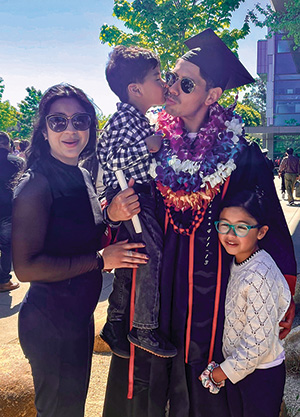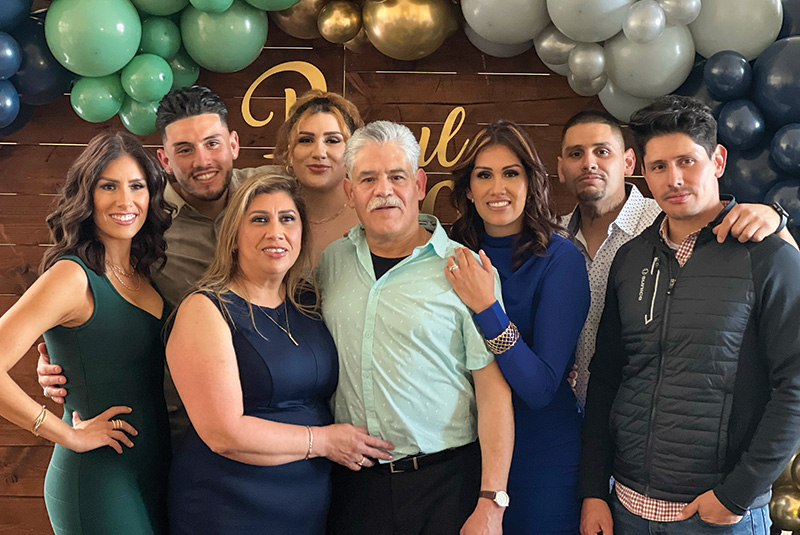
Javier Campos, GCSAA Class A superintendent at the California Golf Club of San Francisco, moved from Mexico to the U.S. as a youngster. Photo by Christina Leung
Javier Campos eventually became a U.S. citizen, a husband, father and a GCSAA Class A golf course superintendent.
His life story unfolded — quickly. It was so long ago that Campos had no idea what was happening. Just as well. As a baby born in Mexico, Campos was so ill that his mother feared the end was near. “She thought he was dying,” says Campos’ sister, Fabiola Saddi.
Fortunately, his health scare had a happy ending — and the rest of his ongoing story has proven that there was no end in sight for Campos’ recovery and rise.
On May 6, 2017, Campos was named superintendent at California Golf Club of San Francisco, ranked in the top 10 of best golf courses in California by Golf Digest. He distinctly recalls that day — first, for the magnitude of it, and second, for the ensuing phone call. “I was over the moon,” Campos says. “I was talking to my wife (Madeline) from the parking lot after my meeting with Glenn (Smickley, the club’s GM). I told her I never want to lose that feeling again. And that I was going to work my ass off.”
Humble beginnings
San Juan de Los Lagos, Mexico, is where life began for Campos. He learned in later years about the illness that rocked his family’s world.
His father, Jose, drove back and forth from Mexico to California, working in construction. Campos’ mom, Aurora, raised four children at the time (two girls and two boys). When Javier fell ill, he couldn’t keep anything down, lost weight and suffered an infection. When family members tried to sit him up, he’d fall over. It was troubling times for the family.
Campos with his family: wife Madeline, daughter Allyana and son Ezikiel. Photos courtesy of Fabiola Saddi

“We didn’t have much money; we borrowed money from family to help Javier. Mom still says it was one of the darkest times for her,” Saddi says. “And he (Javier) didn’t even know it.”
Campos healed. Soon, the family moved to San Francisco.
He recalls their home on Dolores Street. In the one-bedroom home, his sisters slept on bunk beds in the living room while he and his brother, Jose, shared a bedroom with their parents.
“Small house but a big backyard,” Campos says. “We had to be creative with what we did. We shared a bike and made little trails in the yard. There was a big apple tree (he has a scar on his left arm from a fall from that tree). As a kid, almost every day was fun. Life didn’t seem so bad.”
During his youth, Campos went from undocumented immigrant to U.S. citizen. He learned to speak English early on from siblings while later taking after-school classes to learn how to read and write in Spanish. He enjoyed competitive sports and was always a good student. And one thing is certain about his impending journey: His mother, who calls her son Mijo — an affectionate term some Hispanic moms call their sons — was instrumental in his career drive.
“I started hearing more about what happened (his illness) in my teens,” Campos says, “and how much my mother belittled herself by asking friends and family for money and even had a few who declined. It was just more motivation to make sure I showed that her efforts were not in vain.”

A large gathering for Campos and his family.
A crossroads leads to golf
Post-high school life for Campos was all about mulling options.
He considered the police academy because he had friends who joined the police department. Campos also stopped by the U.S. Army and U.S. Marines to inquire about military service as a future. His brother-in-law, Jesus Rodriguez, got Campos thinking about what might be next. Rodriguez worked (and still does) at California Golf Club of San Francisco. Campos pursued. Dressed in a black shirt and jeans, he interviewed at the club with then-superintendent Thomas Bastis, CGCS. “He (Bastis) asked me about my experience. I said I had raked leaves and done yard cleanup. He said, ‘This is a huge yard.’ And then he said, ‘You can start tomorrow.’ That was Aug. 16, 2004,” Campos says. “Before that, I had never stepped foot on a golf course. Everything was so new. But I knew right away how important everything was. I had to be detailed in my work, always pay attention.”
Campos started by raking bunkers. Quickly, he graduated to mowers and anything the crew members were willing to teach him. “Thomas trained me on how to mow greens, and after a few straight lines, he (Bastis) said I was good to go,” Campos says.
Bastis, currently competition agronomist for the PGA Tour, saw Campos’ potential from the get-go. “Good attitude. He inquired enough that made you want to help him,” says Bastis, a 32-year GCSAA member. “I encouraged him. I made him work.”
Others who’ve moved elsewhere impressed Campos in his early years at the club. “It was his poise, his calmness. Staff gravitated to him,” says 23-year GCSAA member Matt Muhlenbruch, CGCS, who now is director of agronomy at Hillcrest Country Club in Los Angeles. “Thomas saw it. I saw it. We all hoped he would be involved in the business. Having worked there speaks to his ability. He’s not going to fail at anything.”
Still, Campos was uncertain about his future. In fact, he departed the club for a semester to take college courses to pursue a kinesiology degree but very quickly regretted leaving the club. “I really missed being at the golf course,” he says.
Bastis welcomed Campos back. He dangled the possibilities for Campos if he truly wanted to stick with it and prove he was sincere about the industry. Bastis mentioned the chance for Campos to be an assistant — or even advance someday to become a superintendent — if first he would attend the turfgrass management program at Rutgers University. Campos sure proved he was sold on school. Not only did he graduate from Rutgers, he also went on to earn a degree in business administration from California State University-East Bay. And then there’s this: Campos earned a first assistant role.
Shadowing every move by Bastis prepared Campos for the future. “I made the best of it,” Campos says. “I learned pretty much every job on the golf course and the process so I could train the crew. It was neat to end up with a great mentor, somebody like Thomas, willing to help me out.”
In 2017, that carrot Bastis dangled in front of Campos came true. Bastis left California Golf Club of San Francisco for the PGA Tour. Campos interviewed for the opening. Smickley, the GM, had been sold for a while on Campos. “I told him he was replacing a legend (Bastis). He (Campos) acknowledged it 100%,” says Smickley, a 46-year GCSAA member. “Great kid, talented superintendent. He really gets it. Javier is down to earth. Unassuming. He takes his job seriously, but not himself too seriously. He does his homework. Great personnel manager, great water manager. He lived up to what we hoped for. He’s revered here. They love him and respect him. He handles green committee meetings, and they listen to what Javier has to say. Everybody is blown away how thorough he is.”
Bastis saw signs long ago, too, that Campos had the tools to succeed. A golf course renovation more than a decade ago showcased those talents. “He was highly mobile, explained the hows and whys of what we were doing. He did a lot of cross-training,” Bastis says. “He’s smart. Bilingual. You can do a lot in this industry.”
When that time arrived for Bastis to go and Campos to ascend, there was no doubt in Bastis’ mind that he was leaving the club in good hands. “It’s not very often the first superintendent job you get is at the Cal Club. It’s not often you’re just handed the keys to a Ferrari,” Bastis says. “I believed in him enough.”
Proud, too. “Javier has continued to elevate the club, better than I did. There never was a gift given to him,” Bastis says. “Everything was earned. I’ve been gone eight years (Bastis was named an honorary club member). They’ve taken care of me. Now he’s the man, and they’re taking care of him. Javier’s a success story, and he’s done a lot with it, and I’m proud of it. It (assisting Campos’ climb in the industry) is one of the most successful things I’ve done in my career.”

California Golf Club of San Francisco opened for play in 1926. It was a longtime home course for 1964 U.S. Open champion Ken Venturi. Photo by Christina Leung
Maintaining a standard
18.
Campos will do whatever it takes to extend that to 19. Then 20, 21, 22 … you get the picture.
For 18 years in a row, the A1/A4 bentgrass greens at the California Golf Club of San Francisco have been Poa annua free. Fast and firm conditions with drives that roll at least 70 yards are recognized as a staple at the private club, which opened for play 99 years ago and once hired legendary golf architect Alister MacKenzie to redo bunkers.
There’s no secret to how Campos and his staff — featuring first assistant Thomas Dunn, second assistant Clay Varnbuhler and the remainder of a crew that is 70% of Mexican descent — tackle their turf. “I tell people the way we manage is that less is more. Less disruption. We’ll go as long as four months without any nitrogen on greens,” says Campos, a 10-year GCSAA member. “In terms of fertility, yes, we do fertilize, but nitrogen is very restricted, and we go as long as four months without any nitrogen. Naturally, there is a lot more to fertility, but nitrogen is what most guys see as the ‘it’ component. We really believe in tipping the scales in favor of the bentgrass. And, if you are constantly feeding it, our thought is that you are potentially helping any Poa that loves being fed. Our greens program, though simplistic, is complex because there are various components to it that all play a big role. We are always looking for that next tool to support our big-picture process, if that makes sense.”
Campos also is intent on developing a crew that is challenged and rewarded when the time comes.
“Two of my guys have been chipping away at their GED and completing English courses, and I have done what Thomas did for me by being flexible and figuring out how they can still complete their courses while working the schedule we do,” Campos says. “Sometimes it is allowing for a longer lunch break to complete a course online or working a different schedule so that they can go to campus and come back and complete their shifts. I really believe everyone is motivated differently; and, for some guys, getting this type of help goes a longer way than more money.”
They do receive perks. Examples: Starbucks gift cards for those chosen to be the most improved employee or for accomplishing something exemplary or achieving an endeavor to set them apart. “That really has gone a long way and is a simple gesture but, more importantly, guys feel good about standing out in front of their peers,” says Campos, who holds a quarterly barbecue and randomly brings donuts and coffee.

These are the days gone by for Campos (center) and his sisters, Fabiola Saddi (right) and Carolina Campos.
Dreaming big
Yes, that indeed was a golf cart exiting a gate at California Golf Club of San Francisco. Campos was behind the wheel.
He was headed toward the elementary school practically next door. His niece was being promoted that day to middle school, and Campos wouldn’t have missed it for anything. It was another of many exercises that display his character, his sister says. “I’m overprotective of him,” Saddi says. “I look out for him, give him advice. He gives me advice. I never would have thought where he ended up. Things could have gone south for him when he was little. The way he has exceled in everything, put his mind to it in his job … Thomas (Bastis) saw something in him. For Javier, it became attainable. I felt he always had it in him. He’s an amazing father (to Ezekiel and Allyana, his children with wife Madeline). He puts his kids to bed, reads them books, even as exhausted as he could be. I see amazing things in his future.”
California Golf Club of San Francisco has his back. The club supported him when Campos purchased his first home, courtesy of the club’s forgivable loans available to key staff to help them get into the difficult California housing market. That was a giant milestone for Campos. More recently, Campos saw just how far he has come there.
“During an exit interview I did with Angus Vos, my last assistant who landed a job (as director of agronomy at Brentwood Country Club in Los Angeles), we had a great conversation. One of the things that meant so much was that he said he was ready to leave the industry before coming here and working for me,” Campos says, “but, in the end, he felt he had someone that trusted him and gave him an opportunity to grow, and we had a great relationship that he simply thought was unlike anywhere he had been. I showed him that support all the way through the interview process and him calling me to tell me he got the job, weirdly enough, became one of my proudest moments.”
Campos, 38, last spent time in Mexico when he was 19. According to him, maybe he will return at some juncture. Or maybe he won’t go back. “I can’t really say I miss home because I was raised here,” he says.
It might appear that Campos is living the American dream. He certainly has used his interesting life journey to dream big. Now, he wants to share his dreams with his children so they can see what is possible. “I never thought of it like that, the American dream,” Campos says. “What I want is to take advantage of the opportunities I have and do something so that my kids can look up to me, and then do it for themselves.”
Howard Richman (hrichman@gcsaa.org) is GCM’s associate editor.